Oceana
in the canaries
oceana's ranger returns from two months in spain's african jewel plUs 23,000 square miles of deep-sea corals saved
defeating coal plants in chile
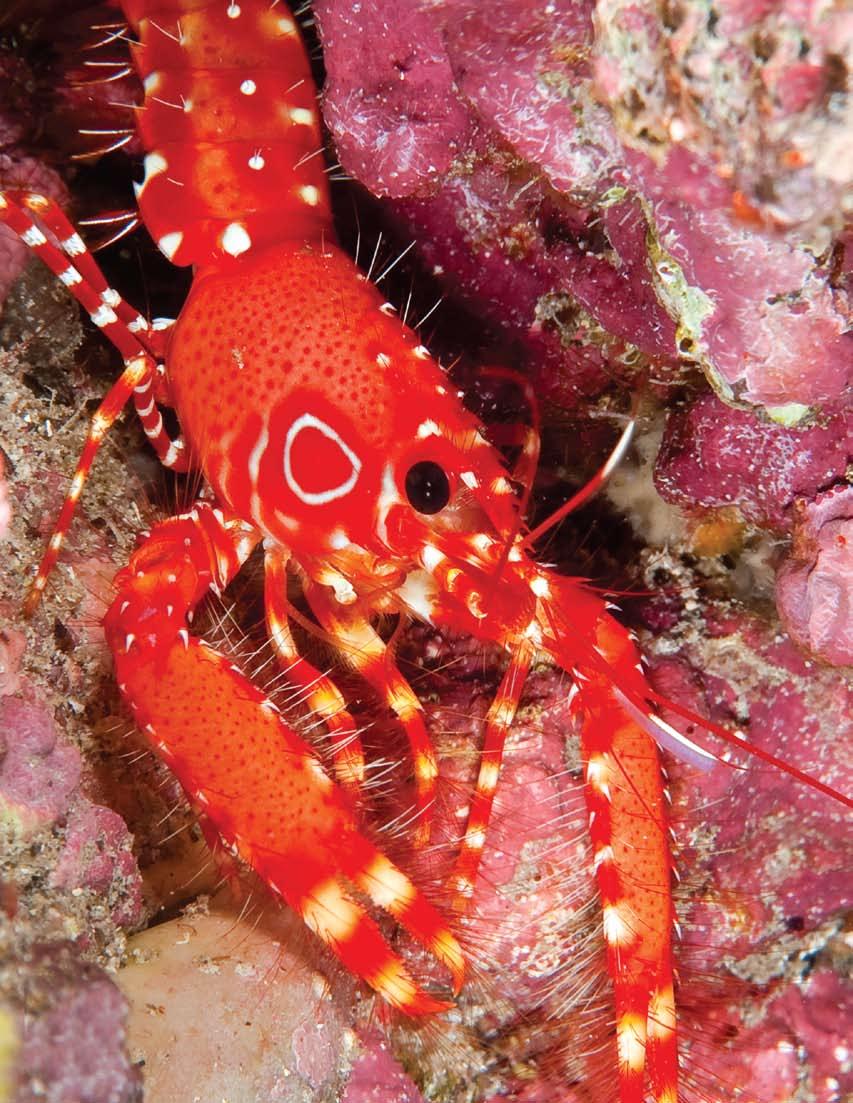
WINTER 2010 oceana.org
The Oceana Ranger and ROV in the Canary Islands.
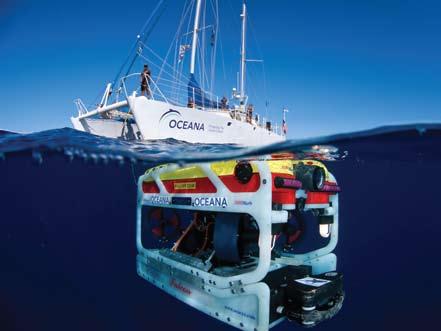
Oceana campaigns to protect and restore the world’s oceans. Our team of marine scientists, economists, lawyers and advocates win specific and concrete policy changes to reduce pollution and to prevent the irreversible collapse of fish populations, marine mammals and other sea life. Global in scope and dedicated to conservation, Oceana has campaigners based in North America, Europe and South and Central America. More than 300,000 members and e-activists in over 150 countries have already joined Oceana. For more information, please visit www.oceana.org.
Board of directors
featUres contents departments
4 Ranger in the Canary Islands
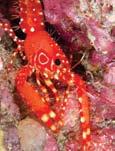
Oceana's campaigners document rare species over two months on the water.

7 January Jones on Capitol Hill
The actress and Oceana spokesperson lobbies for the Shark Conservation Act.
8 Stopping Coal Plants
Oceana launches a new campaign to prevent coal plants in Chile's rich Punta de Choros.
1 CEO’s Note
2 Making Waves
10 Party Photos
The 2009 Partners Award Gala and launch of Oceana's New York office.
13
Chef’s Corner
Cindy and Ted Walters of California's Passionfish.
Keith Addis, Chair Dr. Kristian Parker, Vice Chair James Sandler, Treasurer Simon Sidamon-Eristoff, Secretary Herbert M. Bedolfe, III Ted Danson César Gaviria María Eugenia Girón Stephen P. McAllister Michael Northrop Dr. Daniel Pauly Sally-Christine Rodgers Sam Waterston Valarie Whiting
ocean coUncil Susan Cohn Rockefeller, Chair Lea Haratani, Vice Chair Anne Alexander Rowley Dr. Andrew Bevacqua Pierce Brosnan Deborah Buck Dan and Beth Cort Andrew and Sydney Davis Kelsey Grammer Hardy Jones
J. Stephen and Angela Kilcullen
Eve Kornyei
Larry Kopald Willa and Ted Lutz Carolyn Marks Blackwood
Aaron Peirsol
Nicole Polizois
Linus Roache Ruthie Russ Mark Ryavec
oceana Chief Executive Officer
Andrew Sharpless
Executive Vice President & General Counsel James Simon
Senior Vice President, North American Oceans & Chief Scientist Michael Hirshfield, Ph.D. Vice President, European Oceans and Seas Xavier Pastor
Vice President, South American Oceans & Antarctica Alex Muñoz
Vice President, Belize Audrey Matura-Shepherd
Vice President, Pacific & Senior Advisor Jim Ayers
Vice President, Strategic Marketing & Communications Matthew Littlejohn Vice President, Global Development Bettina Alonso Director, Pacific Susan Murray
editorial staff
Senior Editor
Suzannah Evans
Online Editor
Emily Fisher Graphic Design Lindsay Orlowski
On the Cover
Flaming reef lobster in Tenerife, the largest of the Canary Islands.
Photo © OCEANA | Carlos Suárez
Victoria Stack
Peter Stranger Annett Wolf Nicole Woody
2 | WINTER 2010
4
7
WINTER 2010
© OCEANA |
Lindsay Orlowski
© OCEANA | Carlos Suárez
t he 'fishing a pe'
Talk to people every day about the oceans, as I do, and you encounter a paradox. People love the oceans. Yet most of us are oblivious to the many clear measures showing ongoing ocean collapse.
Perhaps the cause of this paradox is dimly visible in the mists of our early evolution as Homo sapiens
Evidence of popular love of the ocean is easy to find. Consider where many of us go when we are granted the freedom of summer vacation: to the water’s edge. People also like to eat the creatures in the sea. And consider the benefits to human health of the fatty acids present in many fish.
Why aren’t more people loudly insisting on strong action by our policymakers to stop ocean collapse?
There are many reasonable answers. The last ten years – called “The Decade from Hell” in a recent TIME cover story – brought a slew of new and difficult international challenges, including terrorism, financial collapse and climate change. People are understandably distracted. Moreover, the creatures of the sea are invisible to most of us until they show up on our dinner plates.
If you live in the USA, Europe or Japan, assessing the state of the world’s oceans by the range of choices at your grocery
store is deeply misleading. Because the developed world pays the most for fish, the last fish in the world will be served on its plates.
Which brings me to the “aquatic ape” hypothesis. Several iconoclastic thinkers have offered a controversial, but intriguing, hypothesis about what factors drove humans to evolve differently from other primates. Why, for example, are we hairless compared to our primate cousins? Why are we bipedal? Why do we store fat differently? Why are the fatty acids in fish so very good for us?
Their hypothesis is that more than two million years ago, ancestors of ours spent a lot of time in a coastal environment, and that got them interested in capturing and eating fish and other marine creatures. Going into the water in search of seafood drove selection that rewarded hairlessness (for the same reasons that dolphins and whales are hairless mammals), the ability to stand on two feet (it was easier to breathe and the water helped support early efforts to become erect), subcutaneous fat (for underwater warmth, again like a dolphin or a whale) and tuned our metabolism to the benefits of a heavily seafood-based diet.
This hypothesis is highly controversial, and although intriguing to many biologists, is soundly rejected by most paleoanthropologists. They point out that there
is no fossil evidence consistent with the theory.
Oceana is not taking a stand on this question – we have our hands full winning policy changes that will restore and protect abundant oceans. But the idea that we are descended from a group of ancestral apes who discovered fishing is appealing to me. It might explain, for example, our apparently limitless ability to prey on the creatures of the sea. It might also explain why we are drawn to the water’s edge on our vacations. If this is indeed an ancestral attraction, it’s time for us “fishing apes” to stop loving the oceans to death.
For the oceans, Andrew Sharpless CEO, Oceana
Oceana is grateful for the grants, contributions and support it has received from dozens of foundations and companies and thousands of individuals. Oceana wishes to thank all of its supporters, especially its founding funders as well as foundations that in 2008 awarded Oceana grants of $1 million or more: Arcadia Fund, Oak Foundation, The David and Lucile Packard Foundation, The Pew Charitable Trusts, Rockefeller Brothers Fund and Sandler Foundation. For more information, please see Oceana’s annual reports at www.oceana.org.

OCEANA.ORG | 1
ceo’s note
a rctic protections take effect
In December, the U.S. part of the Arctic Ocean was officially protected from expanded commercial fishing. Nearly 200,000 square miles of ocean wilderness – an area much larger than California
– are now closed to commercial fishing unless and until there is adequate information to manage fisheries sustainably in the Arctic’s fragile ecosystem.
Despite the harsh conditions, the Arctic is home to vibrant communities and ecosystems. It provides vital habitat for polar bears, whales, walrus, fish, birds and other animals.
The closure is one of the largest preventive measures in fisheries management history, and will be crucial for protecting the Arctic. The region is warming at twice the rate of the rest of the planet and has seen unprecedented sea ice loss in recent years. Currently undisturbed by commercial fishing nets, trawls and longlines, the U.S. Arctic might have become the next fishing hotspot as waters become more navigable and fish species expand northward as the region continues to warm.
23,000 square miles of deep-sea coral in southeast U.s. protected
After five years of advocacy by Oceana and others in the environmental community and fishing industry, the South Atlantic Fishery Management Council approved a plan to protect more than 23,000 square miles of rare deep-sea coral from North Carolina to Florida from destructive fishing gear.
The plan will restrict the use of bottom trawls, whose nets drag the ocean floor and have destroyed thousand-year-old
coral reefs, including the Oculina banks, an area of vulnerable deep-sea coral habitat off the east coast of Florida. The Oculina banks were eventually protected by the Council, but not before the corals suffered irreversible damage from trawls and dredges.
Deep-sea corals off the southeast coast include hundreds of pinnacles up to 500 feet tall that provide habitat for many species, including sponges that are being
mercury bill clears U. s. house committee
In October, Oceana was instrumental in clearing the Mercury Pollution Reduction Act (H.R. 2190) past a critical legislative hurdle, the U.S. House Energy and Commerce Committee. The bill, which was sponsored by Rep. Jan Schakowsky (D-IL), would require chlor-alkali plants to end their unnecessary use of mercurybased technology in chlorine and caustic soda production. Oceana is now working to ensure the bill's passage in the Senate and on the House floor.
Oceana campaigned for nearly five years to persuade nine factories to switch from mercury-based technology to mercury-free alternatives. Only three companies, Ashta Chemicals, Olin Corporation and PPG Industries, with four factories in the U.S., have refused to switch to cleaner, mercuryfree technology, despite the fact that doing so would eliminate major sources of mercury pollution, make chlorine production more efficient, increase
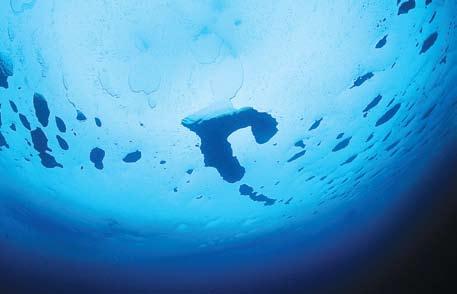
tested to develop drugs for the treatment of cancer, heart disease and more.
The Council’s decision, which will also help restore the long-term productivity of commercially valuable fisheries in the area, has been sent to the National Oceanic and Atmospheric Administration (NOAA). Oceana anticipates the new regulation will take effect in early 2010.
profitability and protect jobs.
In 2009, Oceana reported in a white paper that Ashta Chemicals was continuing to emit mercury despite claiming zero emissions in official reports to the Environmental Protection Agency.
An Oceana scientist documented mercury levels up to 20 times higher than background levels in the area surrounding the Ashta plant in northeast Ohio.
2 | WINTER 2010 maKing WaVes
ma K e WaV es : www.oceana.org/act
left: Underwater view of arctic sea ice.
© Peter Hemming
deepwater canyons saved from trawling
The U.S. government has protected four deepwater canyons off the mid-Atlantic from bottom trawling and dredging, destructive fishing methods that can devastate ecosystems in a single pass.
The four canyons, known as Oceanographer, Lydonia, Veatch and Norfolk, are among the best-documented deepwater
habitats in the U.S. The canyons are home to a multitude of marine animals, including sponges, corals, lobsters and fish.
This landmark action by the Mid-Atlantic Fishery Management Council, which took effect on Nov. 1, banned the use of bottom trawls and dredges in the canyon
areas year-round. The ban was estab lished as part of the rules for fishing for Atlantic tilefish.
Offshore canyons are also important to the region’s recreational fishing com munity. The new regulations will have no impact on fishing for marlin, tuna or other gamefish that swim above the canyons.
loggerhead and leatherback sea turtle petitions advance
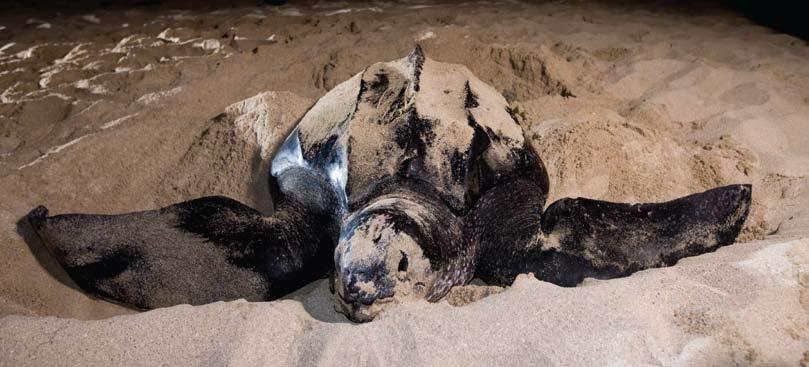
After failing to meet a 12-month legal deadline, and following a lawsuit by Oceana and conservation partners, the U.S. government agreed to respond to petitions from Oceana, the Center for Biological Diversity and the Turtle Island Restoration Network for increased protections for two sea turtle species in U.S. waters off the east and west coasts.
Two of the three petitions focus on populations of loggerheads in the Atlantic and Pacific oceans. The groups have urged the National Marine Fisheries Service to designate the north Pacific and western north Atlantic loggerheads as distinct population segments and to change their status under the
Endangered Species Act from threatened to endangered. The petitions also call for increased protections in the loggerheads’ key nesting beaches and marine habitats.
The third petition urges the government to protect key migratory and foraging habitat for endangered leatherbacks in the waters off California and Oregon by designating the area as critical habitat. Endangered leatherbacks migrate more than 6,000 miles from nesting beaches in Indonesia to feed on the abundant jellyfish in these waters.
A recent worldwide status review showed that northwest Atlantic and north Pacific loggerheads are currently at risk of
extinction. Loggerheads have declined by at least 80 percent in the north Pacific. Meanwhile, Florida beaches, thought to host the second-largest loggerhead nesting population in the world, have seen a decline in nesting of more than 40 percent in the past decade, and recent nesting data showed 2009 to be one of the worst sea turtle nesting years on record.
In addition to demanding that the government protect sea turtles and their habitat under existing law, Oceana continues to work for comprehensive legislation that would protect U.S. sea turtles in the water as well as on land.
Below: a nesting leatherback.
OCEANA.ORG | 3 maKing WaVes
© Tim Calver
In The Canaries
Unveiling Spain's African Jewel
By Emily Fisher
the canary islands are home to rich underwater ecosystems that are among the most vibrant in the world. colorful gorgonians, black coral and rare sponge forests thrive here, thanks to a ban that has prevented bottom trawling in the region since 2005.
In 2009, the Ranger set sail for the Canaries, documenting this special place and many of the unusual species that call it home. Over two months, the crew found a dozen species never before seen in the Canary Islands, and filmed many rare species, such as three-foot-tall glass sponges, Venus fly-trap anemones and lollipop sponges.
The Canaries, a necklace of volcanic islands 60 miles off the coast of northwest Africa, were discovered in the first cen tury A.D. by an explorer commissioned by Roman emperor Augustus. Centuries later, the seafloor surrounding the islands is still mostly unexplored.
The Ranger’s crew completed a total of 81 dives, including 32 with divers and 49 with an underwater robot (ROV) that dove as deep as 2,300 feet – a Ranger ROV record.
In another milestone, Oceana filmed the Saharan seamounts,
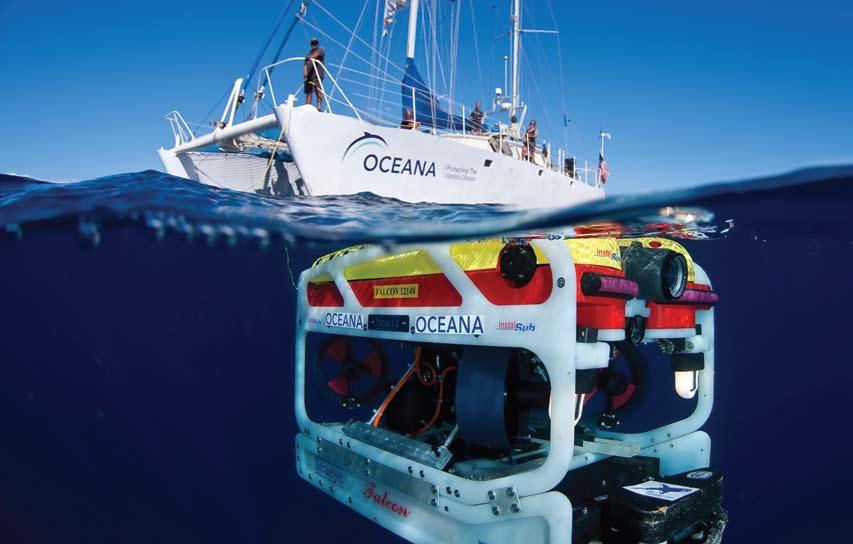
the southernmost seamounts in Spain, for the first time in history. The crew used the ROV to gather images almost 2,000 feet below the surface of the sea. The seamounts rise from the ocean floor 13,000 feet below the surface.
The seamounts were decorated with caves, overhangs and cracks hosting deep-sea sharks, rays and wreckfish, as well as fields of sponges, gorgonians and corals. Especially common in the area were sixgill sharks, which are deep-sea sharks measur ing up to 16 feet long and weighing up to 1,000 lbs.
The crew also spotted two rare species closely related to the famously overfished orange roughy: the Mediterranean silver roughy and the Darwin’s slimehead.
Not all of the crew’s discoveries were positive. The waters around the Canary Islands are oligotrophic, meaning they contain few nutrients to sustain life. As a result, any human encroachment – coastal development or fisheries, for example –has a significant impact on the ecosystems. In shallow coastal areas, the crew found a surprising dearth of fish and a prolifera tion of lime urchins, one of the archipelago’s biggest threats. The urchins devour the island’s algae cover, which is food for many other species.
4 | WINTER 2010
© OCEANA | Carlos Suárez
continued >
clockwise from top left: ranger's roV explores depths beyond the reach of divers; an oceana diver; a common octopus near the island of tenerife; a dusky grouper near Veril de Jandía.
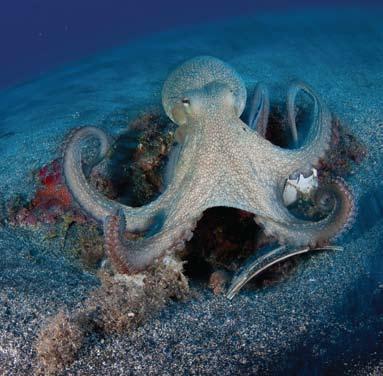
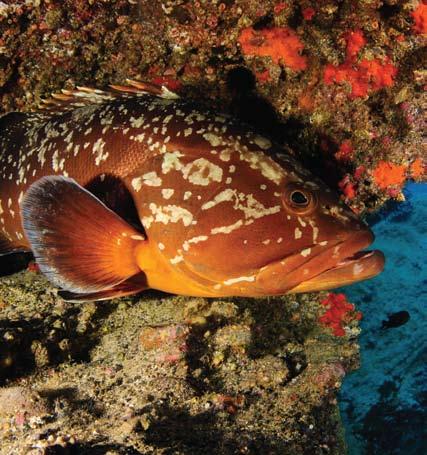
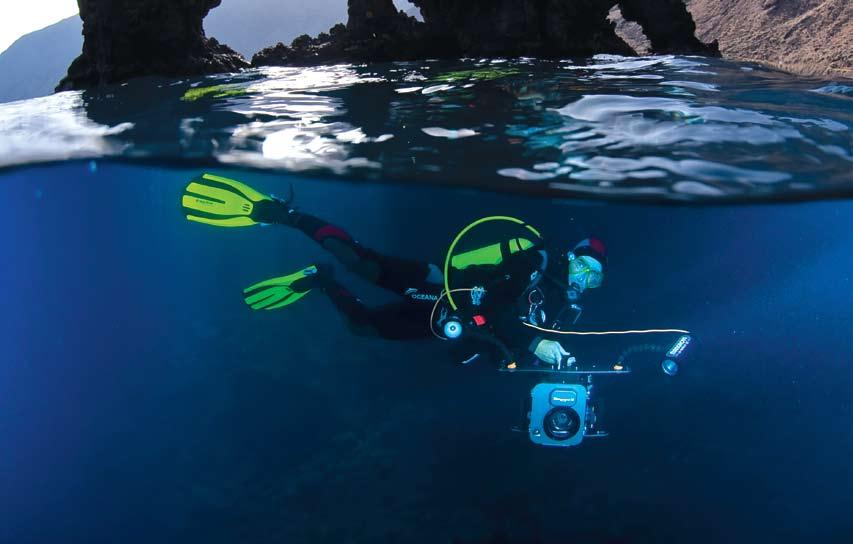
OCEANA.ORG | 5
© OCEANA | Carlos Suárez
© OCEANA | Carlos Minguell
© OCEANA | Carlos Suárez
see more photos and read the cre W's on -B oard diar Y: http://oceana.org/europe/aboard-the-ranger/canary-islands-2009/
top:
Bottom: a madeira rockfish gapes its mouth.

When the crew visited La Palma Marine Reserve, however, the contrast was visible.
“Once again we confirmed the benefits of creating protected areas or reserves,” photographer Eduardo Sorensen wrote in the expedition diary from that day. “As soon as you submerge into the reserve, a healthy ecosystem becomes evident.”
Not only are protected areas visibly healthier, they are also required by the U.N. Convention on Biological Diversity, which states that 10 percent of the global marine environment be protected by 2012. Only 0.15 percent of the islands’ sea surface is protected. Overall, 2.7 percent of the European Union’s waters are protected.
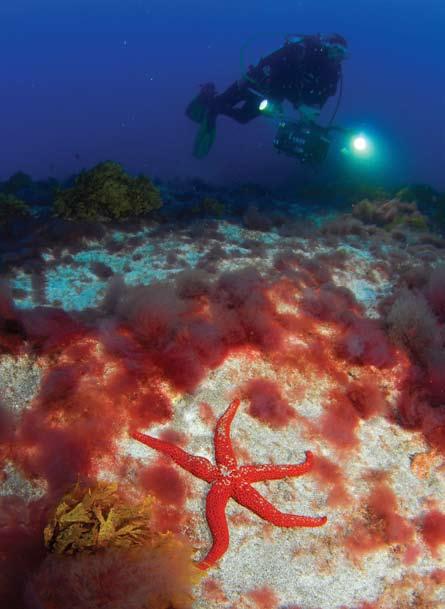
In order to mount a campaign to create new protected areas in the Canaries, it is crucial to first determine what’s at stake in the dark depths of the sea, according to Riki Aguilar, director of the expedition. "The lack of knowledge of the communities existing at great depths is one of the biggest problems when it comes time to decide which areas must be protected,” he said.
Now that the crew is back on the Spanish mainland, they are working on a scientific report on the state of Canarian marine ecosystems, drawing conclusions about the state of the seabeds and the threats they face.
For more information on Oceana's on-the-water campaigns, visit oceana.org.
6 | WINTER 2010
ranger's crew documented many species that were never seen before in the canary islands.
an oceana diver documents the seafloor off gran canaria.
© OCEANA | Eduardo Sorensen
© OCEANA | Eduardo Sorensen
Morocco
Western Sahara SpainPortugal
Canary Islands Algeria
< continued
January Jones: A Voice for Sharks
By
actress January Jones made her first visit to Capitol Hill in September when she came to lobby on behalf of the Shark Conservation Act of 2009.


Along with Oceana federal policy direc tor Beth Lowell and marine scientist Eliz abeth Griffin, Jones, who is best known for her role as Betty Draper on the hit drama “Mad Men,” visited with members of Congress including Senators Frank Lautenberg (D-NJ) and John McCain (RAZ). Senator McCain surprised her with a quick tour of the Capitol building.
“The spontaneous, private tour of the Capitol by Senator McCain was a real highlight,” Jones said. “But my true favor ite part was seeing that the process can work and that it’s possible to pass good legislation. It was great to talk with the senators and to have them listen to what I had to say.”
Jones’ message of shark conservation was a hit.
“Two of the senators immediately signed onto the bill,” she said. “I was surprised by how supportive they were. I think it’s a testament to the great work being done by Oceana.”
Less than two months after Jones’ trip to the Capitol, the Senate Commerce, Science and Transportation Committee passed the Shark Conservation Act. The House of Representatives passed similar legislation in March.
The legislation would require all sharks caught in U.S. waters to be landed whole with their fins still attached. This bill would put an end to shark finning, the process of cutting off the fins and discarding the carcass at sea. Landing sharks with their fins still attached allows for better enforcement and data collection for stock assessments and quota monitoring. The act would also close a loophole that allows the transfer of fins at sea as a way to get around current law. Additionally, the bill would allow the United States to take
action against countries whose shark finning restrictions are not as effective.
Now, the Shark Conservation Act must pass the full Senate. Inspired by her success in her first visit to Washington, Jones is eager to continue helping pro tection sharks from extinction.
“Yes,
come back – to the White House ceremony for the bill signing!” she said.
OCEANA.ORG | 7
January Jones met with s enator frank l autenberg ( d n J) during her visit to the h ill.
I would like to
© OCEANA | Lindsay Orlowski
© OCEANA | Lindsay Orlowski
Suzannah Evans
Saving Punta de Choros
By Suzannah Evans
OCEANA | Jim Simon
top: members of oceana's board of directors visited punta de choros in september to witness the area's spectacular wildlife. Bottom: oceana chief scientist and vice president for north america, mike hirshfield, walks with board member dr. daniel pauly on the chilean shore.

Along Chile’s north-central coast, the ocean’s currents push a swell of nutrient-rich, cold water from the depths to the surface. This natural phenomenon, known as a coastal upwell ing, occurs in a few places around the world where the conditions are just right, and fosters a bonanza of marine life.
At this particular upwelling, near Punta de Choros, the plankton-rich waters are buoyed by the Humboldt current coursing northward from Antarctica. The upwelling supports a huge com munity of wildlife. Eighty percent of the world’s endangered Humboldt penguins breed here. Marine mammals that would normally migrate in search of food stay here, including a permanent population of bottlenose dolphins. The incredibly rare blue whale can be seen here, as well as endangered diving petrels.
One of Chile’s most important fisheries, the Chilean abalone – a mollusc also known as loco – is located here, supplying as much as 60 percent of the country’s abalone. Additionally, the region’s stun ning vistas and guaranteed wildlife sight ings make it a prime tourist destination.
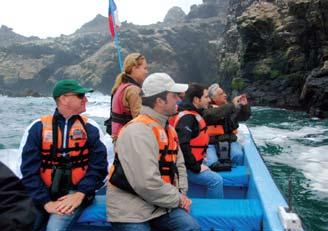
This vibrant area is already partially pro tected as a marine protected area, Chile’s first, designated in 2005. But the marine reserve around the islands of Choros and Damas isn’t enough to protect this natural spectacle.

Developers have proposed building three thermoelectric, coal-fired power plants less than 12 miles south of Punta de Choros and the marine reserve. These plants pose a multitude of threats to a region that is one of the world’s biodiver sity hotspots.
Located upstream from Punta de Choros, emissions from the plants would arrive at the upwelling area in a matter of minutes. Oil spills from ships carrying coal to the plants would seep there in a couple of hours, and the local currents would retain the pollution within the area. In the meantime, mercury emissions from the plants would contaminate the Chilean abalone and damage an industry critical to the region’s economic health.
But the most immediate damage could come from the anti-fouling chemicals the plants would dump into the ocean
8 | WINTER 2010
Oceana launches a new campaign to prevent the construction of three coal-fired power plants in one of Chile's most diverse ecosystems.
©
© OCEANA | Jim Simon
every day, along with thousands of gal lons of hot water, according to Dr. Carlos Gaymer, a professor with the Universidad Católica del Norte in La Serena, Chile and Université Laval, Québec, who has studied the potential effects of power plants on the Punta de Choros area. Thermoelectric plants like the ones pro posed here dump huge amounts of water that is 10 degrees warmer than the cool waters of the Punta de Choros upwell ing. According to Gaymer, the hot water and anti-fouling chemicals is a lethal mix to Chilean abalone. In trials run by Dr. Katherina Brokordt at the Center for Advanced Studies in Arid Zones in Co
quimbo, Chile, using tempera tures below what would actually come from the plants, all the abalone died within weeks.
“We know that they don’t have more than three weeks,” Gaymer said. “After more than three weeks, all the marine life will be killed – and they were very conservative in their test.”
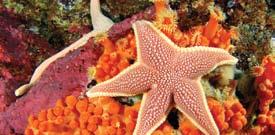
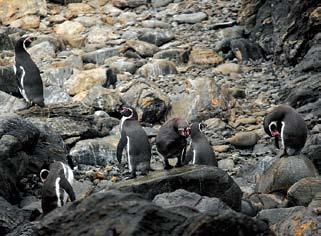
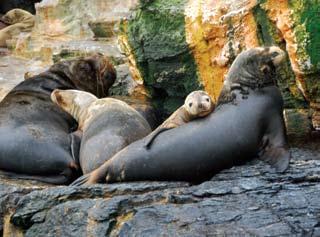
In September, Gaymer joined Oceana’s board of directors and senior staff on a day trip to Punta de Choros, where the group witnessed firsthand the region’s stunning biodiversity. Gaymer presented his research on the devastating effects the power plants would have on wildlife, the surrounding habitat and human health.
The arguments against build ing the coal plants in such a pristine area are strong, but Gaymer acknowledges the challenges.
“It’s clear to every person that sees all these arguments, they all say the same thing, it’s crazy to do something like that here. This place is too important for threatening in this way,” he said. “The problem is that political decisions sometimes say the opposite.”
oceana’s campaign
oceana and the local community’s fight to protect the health and ecology of punta de choros from the development of three coal-fired power plants met with early success in november when the government of chile declined to permit suez energy to build a port necessary for delivering coal to the proposed Barrancones plant.
"this is an encouraging sign in our fight against the serious damage that the proliferation of these power plants can lead to in chile,” said alex muñoz, vice president for oceana in south america. “coal is one of the most polluting energy sources in the world and we should start to replace it with cleaner alternatives.”
in addition to halting the development of power plants near punta de choros, oceana also seeks to set standards for emissions of carbon dioxide and mercury and the use and discharge of water from existing coal-fired power plants in chile, which currently has no applicable standards. since 2005, the chilean government has approved 11 projects for power plants currently in various stages of construction, and another 11 projects are being evaluated.
OCEANA.ORG | 9
Emissions from the plants would arrive at Punta de Choros in a matter of minutes. Oil spills from ships carrying coal would seep there in a couple of hours.
top: south american sea lions. Bottom: endangered humboldt penguins nest at punta de choros.
© OCEANA | Eduardo Sorensen
© OCEANA | Eduardo Sorensen
© OCEANA | Jim Simon
see more photos : http://oceana.org/america-del-sur/prensa/oceana-en-punta-choros/
The 2009 Partners Award Gala


Oceana honored Dr. Deepak Chopra and Arianna Huffington at its sixth annual Partners Award Gala on November 20. The celebration was held at the Los Angeles home of Oceana chairman Keith Addis and his wife, Keri Selig. Proceeds from the Partners Award Gala support Oceana’s campaigns to stop overfishing, protect habitat and stop pollution.
Dr. Deepak Chopra is a globally-recognized author of fifteen best-selling books on mind-body health, quantum mechanics, spirituality and peace. He has devoted his life to connecting people in order to build a just, peaceful and sustainable world and environment.
Arianna Huffington is the co-founder and editor-in-chief of the Huffington Post, as well as the author of 12 books. Widely recognized as a leading voice on environmental and conservation issues, she was named one of the world’s most influential people by Time magazine.
The honorees and 225 guests were treated to a performance by Eurythmics co-founder and guitarist Dave Stewart, who also introduced Dr. Chopra. The silent auction items included a trip to Belize in support of Oceana’s campaign to save sharks with actress and campaign spokesperson January Jones.
The Partners Award acknowledges visionary leaders who are committed to rich, high-level discourse to improve our world. Chopra and Huffington join an impressive list of changemakers, including former President Bill Clinton, Trudie Styler and Sting, Pierce Brosnan, Ted Danson, Sam Waterston, Don Henley, Jean-Michel Cousteau, Dr. Daniel Pauly, thenSenator Hillary Clinton and former Vice President Al Gore.
10 | WINTER 2010
oceana chairman Keith addis, board member ted danson, January Jones and ceo andrew sharpless.
© Weber Sinh | Oceana
© Dahlhouse Productions | Oceana

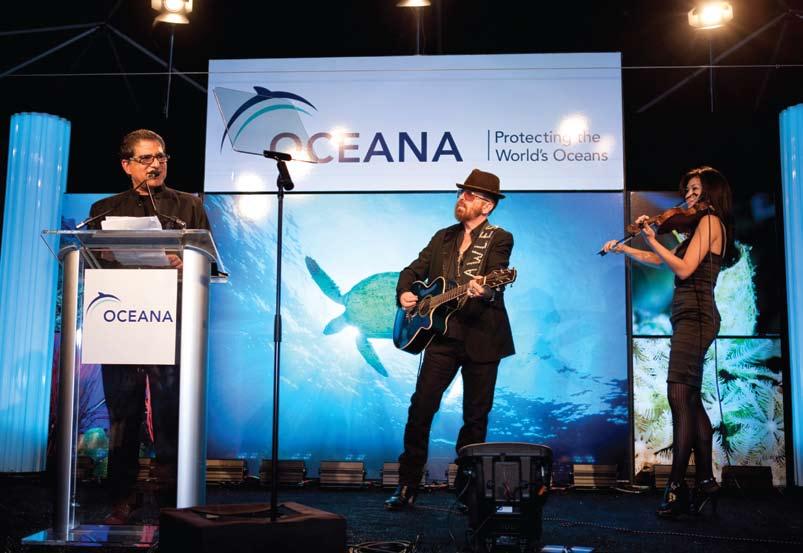
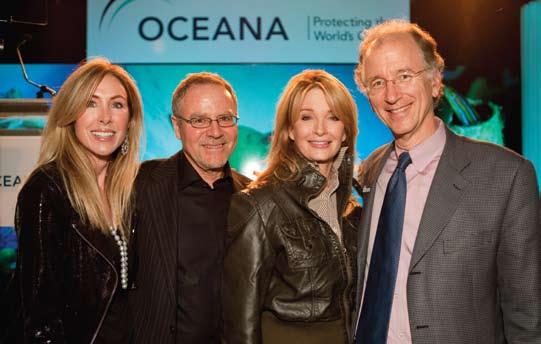
OCEANA.ORG | 11
honorees arianna huffington and deepak chopra.
honoree deepak chopra presented a poem with the musical accompaniment of eurythmics guitarist dave stewart.
patricia and michael Berns, dierdre hall and andrew sharpless.
© Weber Sinh | Oceana
© Weber Sinh | Oceana
© Dahlhouse Productions | Oceana
NY Launch Party

On October 19, Brenda and Alexander von Schweickhardt graciously opened their beautiful Manhattan home to celebrate the launch of Oceana’s New York office.


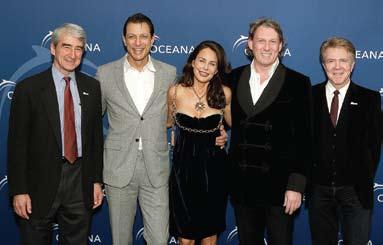
The event was sponsored by Tiffany & Co. and was attended by Oceana board members Ted Danson and Sam Waterston, and Ocean Council chairwoman Susan Cohn Rockefeller. Honored guests included Jeff Goldblum, Tommy, Dee and Ally Hilfiger, Joyce and John Varvatos, Sarah Farcy McNitt, Gina Gershon, New York Jets tackle Damien Woody and his wife Nicole, New York gubernatorial candidate Rick Lazio, along with supporters Bettina Zilkha and Jean Shafiroff.
Oceana chairman Keith Addis and executive vice president Jim Simon were there to welcome the guests and encourage the attendees to support Oceana’s mission to protect and preserve the world’s oceans.
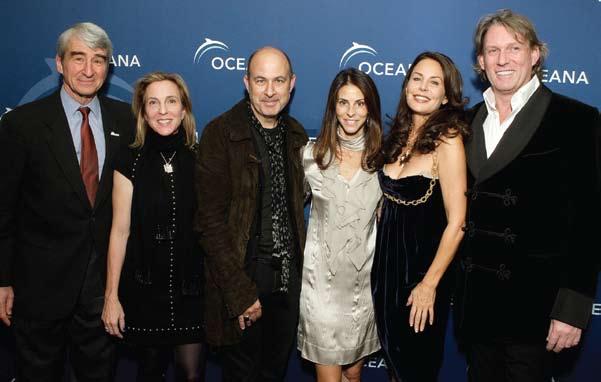
12 | WINTER 2010
top: sam Waterston with ocean council members ted and Willa lutz. Bottom: nile rodgers and mick Jones.
oceana board member sam Waterston, ocean council chair susan cohn rockefeller, John and Joyce Varvatos, Brenda and alexander von schweickhardt.
oceana board member sam Waterston, Jeff goldblum, Brenda and alexander von schweickhardt and oceana chairman Keith addis.
damien and nicole Woody with angela and steve Kilcullen.
© John Dee
© John Dee
© John Dee
© John Dee
© John Dee
passionfish
the husband-and-wife team behind passionfish in pacific grove, california, went green long before it was trendy.
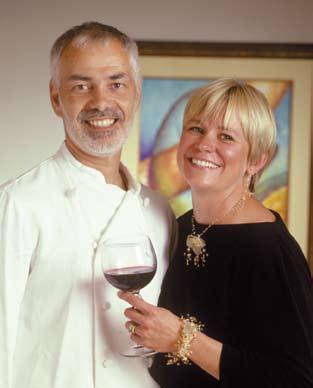
Ted and Cindy Walter – a chef and the daughter of a fisherman – have been vocal proponents of the sustainable seafood movement ever since launching their restaurant.
“We opened Passionfish restaurant and planned to serve the catch of our local fisherman,” said Cindy Walter. “We were disappointed to find few of the local families I had known bringing in the harvests we’d come to expect. This was a situation we could not ignore.”
Now, Passionfish is a respected destination for sustainable seafood, and the Walters welcome the conversation when diners ask why bluefin tuna or Chilean sea bass aren’t on the menu.
“There are plenty of seafood choices that are sustainable,” Cindy said. “We need to remember that the ocean sustains our life, and offer a little more respect and thanks back to our blue planet.”
striped Bass
with moroccan chickpea salad
1 cup chopped fresh cilantro leaves cup chopped fresh mint
¼ cup fresh lemon juice 3 garlic cloves
1 cup olive oil 6 6-7 ounce bass fillets
for the moroccan salad
2 large red bell peppers
2 flat breads (such as pita bread)
1 15½ oz. can chickpeas, drained
1 cup walnuts, toasted and coarsely chopped
¼ cup raisins
2 tbsp. drained capers
2 tbsp. olive oil
Charmoula
Serves Six
for the charmoula
1 tbsp. fennel seeds
2 tsp. coarsely chopped fresh rosemary
1 tsp. cumin seeds
1 tsp. dried crushed red pepper
1 tsp. whole white pepper corns
1 cup coarsely chopped fresh Italian parsley leaves
Combine first five ingredients in spice grinder until finely ground. Transfer to blender. Add parsley and next four ingredients. With blender running, gradually add oil and blend until course puree forms. Season to taste with salt.
Place fish on large plate. Pour ¾ cup charmoula over fish, turning to coat evenly. Cover and refrigerate for at least

learn more : visit www.passionfish.net
one hour and up to one day. Cover and refrigerate the remaining charmoula to use as dressing for salad.
Moroccan Salad
Char bell peppers directly over gas flame or in broiler until blackened on all sides. Transfer to paper bag and seal tightly. Let stand for 15 minutes. Peel, seed, and chop peppers. Toast flat bread directly over gas flame or in broiler until crisp and charred on both sides. Tear into bite size pieces.
Preheat oven to 400°F. Place peppers, bread, chickpeas, and next four ingredi ents into a large bowl. Add ¾ cup charmoula and toss to coat. Season with salt and pepper.
Heat oil in large ovenproof non-stick skillet over medium-high heat. Add fish with marinade still clinging to it, and cook until brown, or about 3 minutes on each side. Transfer skillet to oven and roast fish until thoroughly cooked, about 8 minutes.
Place salad on each serving plate. Top with bass fillet and serve.
OCEANA.ORG | 13 chef’s corner
1350 Connecticut Ave. NW, 5th Floor Washington, DC 20036 phone: +1.202.833.3900 toll-free: 1.877.7.OCEANA
Oceana is published by Oceana Inc. For questions or comments about Oceana, or to subscribe to Oceana, please call Oceana’s membership department at +1.202.833.3900, e-mail membership@oceana.org or write Oceana, Member Services, 1350 Connecticut Ave. NW, 5th Floor, Washington, D.C. 20036, USA.
a bout oceana
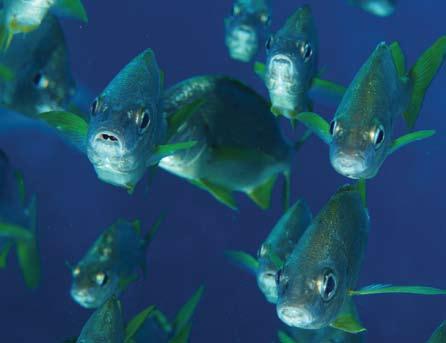
oceana campaigns to protect and restore the world’s oceans. our teams of marine scientists, economists, lawyers and advocates win specific and concrete policy changes to reduce pollution and to prevent the irreversible collapse of fish populations, marine mammals and other sea life. global in scope and dedicated to conservation, oceana has campaigners based in north america, europe and south and central america. more than 300,000 members and e-activists in over 150 countries have already joined oceana. for more information, please visit oceana.org.
Give today at Oceana.org/give
Oceana’s accomplishments wouldn’t be possible without the support of its members. You can help Oceana fight to restore our oceans with your financial contribution. Call us today at 1.877.7.OCEANA, go to our website www.oceana.org/give and click on “give today” or use the envelope provided in this newsletter. You can also invest in the future of our oceans by remembering Oceana in your will. Please contact us to find out how. All contributions to Oceana are tax deductible. Oceana is a 501(c)(3) organization as designated by the Internal Revenue Service.
Oceana’s Privacy Policy: Your right to privacy is important to Oceana, and we are committed to maintaining your trust. Personal information (such as name, address, phone number, e-mail) includes data that you may have provided to us when making a donation or taking action as a WaveMaker on behalf of the oceans. This personal information is stored in a secure location. Credit card donations through the Web site are made via a secure server. Like other non-profits, Oceana may make contact information (not including e-mail addresses) available to other organizations we believe may be of interest to our members and supporters. If you would like to review the information in our files, correct it, or ask Oceana to refrain from sharing your contact information with other organizations, please contact us by writing us an e-mail at info@oceana.org, by calling Oceana’s membership department at +1.202.833.3900, or by writing to us at Oceana Member Services, 1350 Connecticut Ave. NW, 5th Floor, Washington, D.C. 20036. We will be happy to accommodate your request.
Oceana is a member of EarthShare, a federation that represents the nation’s most respected environmental and conservation charities in hundreds of workplace giving campaigns across the country. EarthShare’s payroll contribution program allows donors to direct their contribution to Oceana; to any combination of EarthShare’s members; or to all of them through one general gift to EarthShare! To find out more about how you and your workplace can support Oceana through an EarthShare campaign, please email info@oceana.org or visit EarthShare’s web site at earthshare.org
14 | WINTER 2010
Global | Washington, DC Europe | Brussels | Madrid North America | Boston | Juneau | Kotzebue | Monterey | New York | Portland | St. Petersburg Central America | Belize City South America | Santiago
Printed with Eco-Ink — low volatility vegetable oil-based ink on 25% post-consumer recycled, processed chlorine free paper produced using 100% wind power in a carbon neutral process.
© OCEANA | Carlos Minguell
maKe eVerY daY earth daY


































